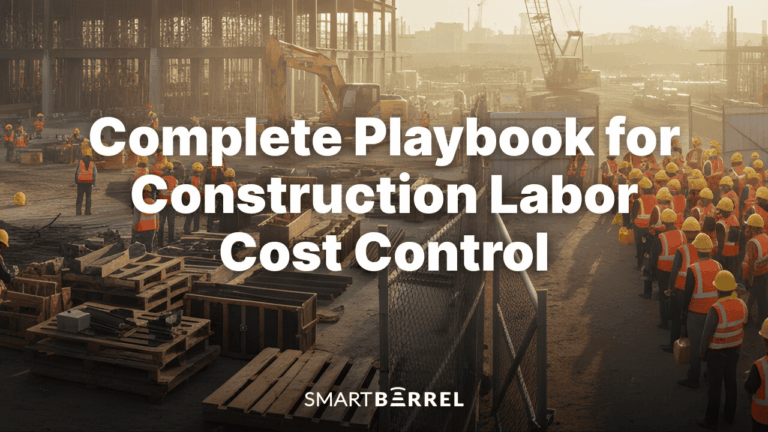Keeping cash flow steady is one of the toughest parts of any construction project. That’s where a construction draw schedule comes in. A well-built draw schedule sets clear payment milestones, keeps subcontractors moving, and helps avoid disputes with owners or lenders. But when payment requests depend on paper timesheets or scattered documentation, the process slows down, cash flow gets stuck, and projects fall behind.
To keep payments on track, contractors need reliable proof that work is complete and payment is justified. Verified jobsite data provides the kind of evidence that turns a stalled payment into an approved one.
What is a Construction Draw Schedule?
A construction draw schedule is a financial plan that contractors use to track when and how project funds are requested and disbursed. Draw schedules are managed by GCs to plan and request payments from owners. Subcontractors and field teams feel the impact because their pay flows through those milestones.
When implementing a draw schedule, draw payments are disbursed upon milestone completions rather than receiving all the money upfront. Some common milestones include site prep, structural elements, interior and exterior finishes, and the completion of the job.
Draw schedules are crucial for contractors who want to control:
- Cash Flow
- Steady cash flow throughout the project to pay labor and materials on time.
- Accountability
- Payments are directly linked to progress.
- Transparency
- Owners and stakeholders know how money is being spent.
- Timeline of the project
- GCs have the flexibility to make adjustments based on milestone completions.
It’s important to note that 5-10% of the final payment is withheld until the project is completed to satisfaction.
Get Control of Your Time Tracking
How Construction Draw Schedules Lead to Project Stalls and Disputes
Construction draw schedules can be a frequent source of project stalls and disputes. The root cause is a lack of verifiable data to support draw requests. Specific factors that contribute to these problems are usually missing daily logs, outdated completion percentages, and unverified labor costs.
Missing Daily Logs
Daily logs are a record of everything that happened that day. Missing or incomplete logs create a glaring void in verifying the project timeline. Proving a specific milestone has been achieved or that a certain percentage of work is complete becomes difficult. With no verification, the owner or lender can delay releasing project funds.
When changes in the scope of work or resource issues arise due to inclement weather or poor site conditions, contractors find themselves in disputes over who is responsible when the project falls behind.
Daily logs often capture workforce counts, hours, and materials used. But without verified time tracking, these records may not be accurate enough to support labor-related draw requests. An inability to verify labor hours makes it harder to justify labor costs separately from materials, delaying draw requests.
As a vital communication tool between the field and the office, and the owner and lender, daily logs are key to avoiding disputes and building trust.
Outdated Completion Percentage
Outdated completion percentages are another major source of disputes. Instead of a smooth construction payment schedule, owners realize they have overpaid, or contractors learn they’ve been underpaid.
When completion percentages are inaccurate, forecasting for additional draw requests or deadline extensions is nearly impossible and negatively impacts the overall financial planning.
If a reported completion percentage doesn’t match what the designated inspector observes on site, it shows a lack of transparency. Owners and lenders are then entitled to reject draw requests, leaving the contractor to eat all the costs.
For contractors working on construction loans, lenders have strict requirements for verifying progress before approving draw requests, such as accurate completion percentages.
Unverified Labor Costs
Without verified time-tracking, owners and lenders can suspend draw schedules if they suspect inflated labor hours or other unnecessary hours are being billed.
Contractors need to tie labor hours to milestones or cost codes to justify their billing. If there’s no verifiable data on who was on site for how long or the work completed, contractors can’t accurately calculate their labor costs. When change orders or rework come up, they’ll have no baseline to justify the costs.
It’s the same when project schedules fall behind. Contractors may need to work increased hours or bring in additional crews. Without verifiable proof, recovering payment for added hours or extra crews becomes an uphill battle.
Key Elements of a Strong Draw Schedule
Detailed Scope of Work
- Strong draw schedules need a detailed scope of work. Any guesswork is a guarantee for disputes throughout the project.
- Tasks, labor, and materials should be clearly outlined in the contract to ensure that draw requests and payments align with expectations.
Schedule of Values (SOV)
- Every contractor’s SOV assigns a specific value or cost for all the components and tasks of the project.
- Break down your SOV into a manageable, itemized list.
- The larger or more complex a project is, the SOV should reflect labor and material costs in similar detail.
- Meticulous tracking eliminates broad “lump sum” items.
- Strong construction draw schedules directly align with the SOV to ensure that draw requests correspond to an accurate job completion percentage.
Project Milestones
- Draw requests are tied to verifiable milestones that you’ve laid out in your draw schedule.
- Make these milestones transparent.
- Following the detailed scope of work, each milestone will reflect the actual job completion percentage.
- Setting realistic and achievable timelines for milestones gives contractors confidence and builds trust with the owner or lender.
Clear Documentation
- Provide documentation of labor hours (supported by verified time) and receipts for materials.
- Always continue to update your SOV. A running tally showing the job completion percentage is strongly suggested to keep the owner and lender happy.
- Signed waivers from all subcontractors and suppliers confirming they’ve been paid for their work covered by the draw schedule protect the owner from future liens.
- Daily logs supported by verified labor data
- Approved signed change orders during the project, with clear cost and schedule impacts.
- Documentation of successful inspections confirming milestone completion and quality.
- Visual evidence of work completed.
Verification Process
- A system for a designated inspector to verify the reported progress and quality of work before funds are released.
- Setting clear expectations for how quickly draw requests will be approved and released, to prevent delays or disputes.
Retainage
- As mentioned, a retainage of 5-10% of the final draw is withheld until the project is satisfactory.
- In this vein, contractors should include clear conditions for the release of retainage outlined in the project contract.
Contingency Planning
- A smart contractor should request a contingency fund based on the level of risk, complexity, and difficulty of a project.
- Common contingency funds make up around 10% of the total project budget.
- A process needs to be in place to define how quickly that draw request is approved.
Strong Communication
- Identify and name the personnel responsible for all documentation related to the construction draw schedule.
- Schedule regular meetings with stakeholders to review progress, discuss challenges, and proactively address potential issues before they become disputes.
- Creating, using, and sharing templates for draw requests and progress reports to ensure consistency and clarity.
Get Control of Your Time Tracking
Streamlining Construction Draw Schedules with Verified Time Tracking
Verified time tracking plays a critical role in expediting construction draws by providing verifiable proof of labor costs. Utilizing time-tracking software, such as SmartBarrel, supports faster draws.
1. Eliminates Disputes
- SmartBarrel uses AI-powered biometric facial verification to provide verified proof of who was on site and when and where they clocked in and out, leaving no room for argument about labor hours.
- Smartbarrel eliminates “buddy punching” and time theft, ensuring that the billed labor hours accurately reflect work performed and the daily log.
- Verified time tracking backs up the labor portion of your draw request with verifiable time data. This directly confirms the labor component of a draw request, which is often a significant portion of the total draw request.
2. Accurate Completion Percentage
- SmartBarrel verifies and records labor hours, which can be used alongside project updates to validate progress against completion percentages.
- With real-time verified time data, project managers can see how quickly tasks are progressing to compare actual labor hours to what’s allocated for on the draw schedule and keep all parties up-to-date on the project.
- Since you now tie your construction draws to specific milestones, SmartBarrel gives you the verified time data tied to each milestone, so you can track hours with confidence.
3. Documentation and Verification
- SmartBarrel eliminates paper timesheets and manual entry by providing verified labor data that can be incorporated into daily logs.
- SmartBarrel integrates with systems like Procore, CMiC, and Viewpoint to streamline documentation. AG Structures integrated SmartBarrel with their Procore software, helping them confirm labor hours used to support billing rates.
- SmartBarrel also offers features like GPS and photo verification to give owners or lenders remote access to real-time data tied to tasks and milestones, giving owners and lenders visibility into labor progress.
4. Improves Cash Flow
- Contractors can confidently submit draw requests, knowing their request is well-supported thanks to verifiable data from SmartBarrel.
- Because the labor data is verified, owners and lenders are more likely to approve draw requests without pushback.
- SmartBarrel’s verified time tracking accelerates draw request approvals, and contractors can focus on the job at hand and maintain momentum to finish the project on time.
5. Builds Trust and Transparency
- SmartBarrel builds trust and creates transparency with its verified time-tracking software. It provides owners and lenders with visibility into who was on site, when, and for how long — giving them confidence in the labor data used to support cost calculations and progress tracking. Transparency and trust are crucial for smooth financial transactions.
How do you build an Effective Draw Schedule?
Step 1: Define the Project Scope, Budget, and Contract
- Confirm that the project’s scope of work is explicitly laid out in the contract, including detailed plans, specifications, material lists, and manpower.
- Labor and material costs should be allocated within the Schedule of Values (SOV) and tied to tasks or milestones in the draw schedule.
- A signed contract mapping out these details, as well as the material list, is a key component of a working draw schedule.
Step 2: Develop a Schedule of Values (SOV)
- Break down the complete draw schedule into a schedule of values.
- The SOV is the backbone of your draw schedule, providing an accurate job completion percentage to speed up draw payments.
- Draft a detailed SOV spreadsheet and have all parties sign and approve the SOV.
Step 3: Integrate with Project Timeline
- Clearly define the milestones and the verifiable completion criteria needed for each draw request
- Your draw requests should align with job completion percentages to avoid disputes and funding delays.
Step 4: Documentation Requirements for Each Draw
- List each piece of documentation required for every draw request.
- Draft a contract outlining milestones and funds, as well as billing rates for your workers and subcontractors.
- Key Documents:
- Up-To-Date SOV
- Documentation of labor hours (supported by verified time) and receipts for materials.
- Signed conditional lien waivers for the current draw schedule.
- Daily Logs
- Verified Time-Tracking Reports
- Approved Change Orders
- Progress Photos and Videos
- Inspection Reports
- A checklist minimizes missing information.
Step 5: Progress Monitoring
- Regular weekly updates on time-tracking and job completion percentage.
- Document progress in real-time while on the jobsite from any device.
- Use SmartBarrel’s verified labor reports to support your project documentation.
- This is crucial in eliminating project delays and identifying the proper time to submit a draw request.
Step 6: Prepare the Draw Request Package
- As each draw milestone approaches, compile a complete draw request package using your verified data.
- Connect hours worked to the relevant milestone so you can back up your labor costs.
- Confirm your labor costs are aligned with your SOV.
- Secure all necessary lien waivers.
- Date-stamp all photos and videos related to your draw request.
- A complete draw request package will include an updated SOV with job completion percentage, all verifiable documentation, and a filled-out draw request template.
Step 7: Submit Verification
- Submit the draw request package to the owner or lender, following the draw schedule outline.
- Send or anticipate the designated inspector to visually confirm job completion percentage and overall quality of work.
- Maintain open communication throughout the draw approval process.
- Sign and document the draw approval immediately.
Step 8: Secure Approval
- First, once funds are received, pay all subcontractors and suppliers according to their contracts.
- Obtain unconditional lien waivers for the work just paid for.
- Many contractors also use direct deposit or similar methods to help subs and suppliers get paid faster.
- Maintain project momentum and continue verifying your data.
Step 9: Review and Adjustment
- After each draw, review how effective your draw schedule is.
- Verify the job completion percentage.
- Document any upcoming issues or potential delays.
- Confirm all parties have access to the project data.
- Prepare your next draw request, including any changes to the draw request template.
- Adjust your SOV accordingly.
Get Control of Your Time Tracking
Simplifying Draw Schedules with Digital Tools
Centralized Data
Instead of stacks of paperwork and physical files, integrate SmartBarrel with your existing software to create a seamless data channel.
Eliminate confusion over outdated information and minimize costly rework with live reporting on labor by project, phase, and task.
In the SmartBarrel dashboard, project admins can assign cost codes by shift in just a few clicks. Once assigned, cost codes carry forward day to day until updated, and can be sent to integrated platforms like Procore, CMiC, and Viewpoint Vista.
Automated Documentation & Reporting
SmartBarrel provides verified time punches, geofencing, and photo data that can be used to support daily logs, eliminating the need for manual field entry.
Facial verification confirms exactly who was on site, when, and where, giving you reliable labor data tied to cost codes for each shift. This verified time data supports job costing and backs up your draw requests with confidence.
With verified labor data from SmartBarrel, contractors can quickly update their Schedule of Values (SOV) and tie hours worked to each milestone, reducing the time spent gathering documentation.
Better Communication & Collaboration
Forget about he-said-she-said and crumpled paper notes. SmartBarrel makes jobsite communication clear and reliable.
Send broadcast texts to entire crews so everyone knows what’s happening. Messages hit workers’ phones instantly and are automatically logged, creating a verifiable record of communication.
Contractors can use SmartBarrel’s SMS tools for time-sensitive updates, keeping crews aligned on project goals and deadlines.
Labor Data That Supports Financial Decisions
SmartBarrel’s dashboard gives contractors a clear view of labor activity across jobs, shifts, and cost codes, helping spot issues early and support accurate job costing.
Verified time-tracking data and full labor transparency build trust across the team — giving owners, lenders, and contractors confidence in your draw schedule.
Wrap-Up
The stronger your draw schedule, the faster you get paid — and the fewer headaches you deal with. Common issues like missing daily logs, outdated completion percentages, and unverified labor costs frequently lead to stalled payments and disputes.
Define your scope, build a detailed SOV, align it to milestones, and track everything with real-time data to prevent delays and maintain momentum.
SmartBarrel gives you verified time data and SMS communication tools to back up every draw request. Every draw is backed by verified proof.
Ready to take the guesswork out of your draw schedule? Book a free demo with SmartBarrel.





